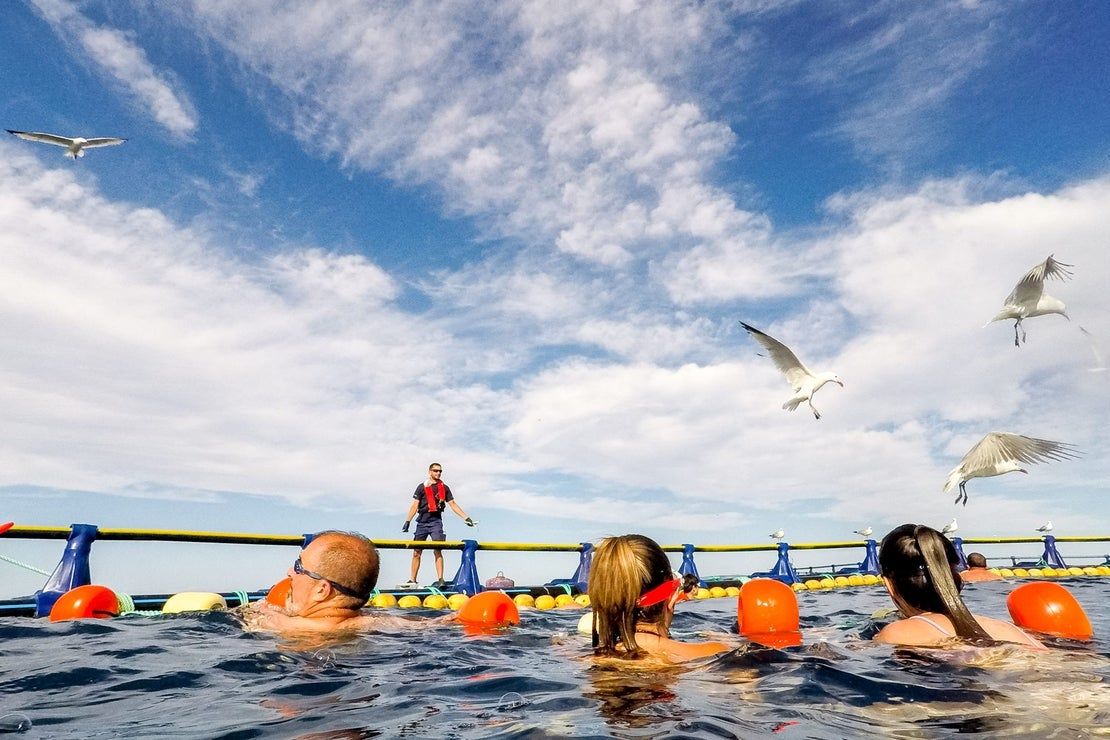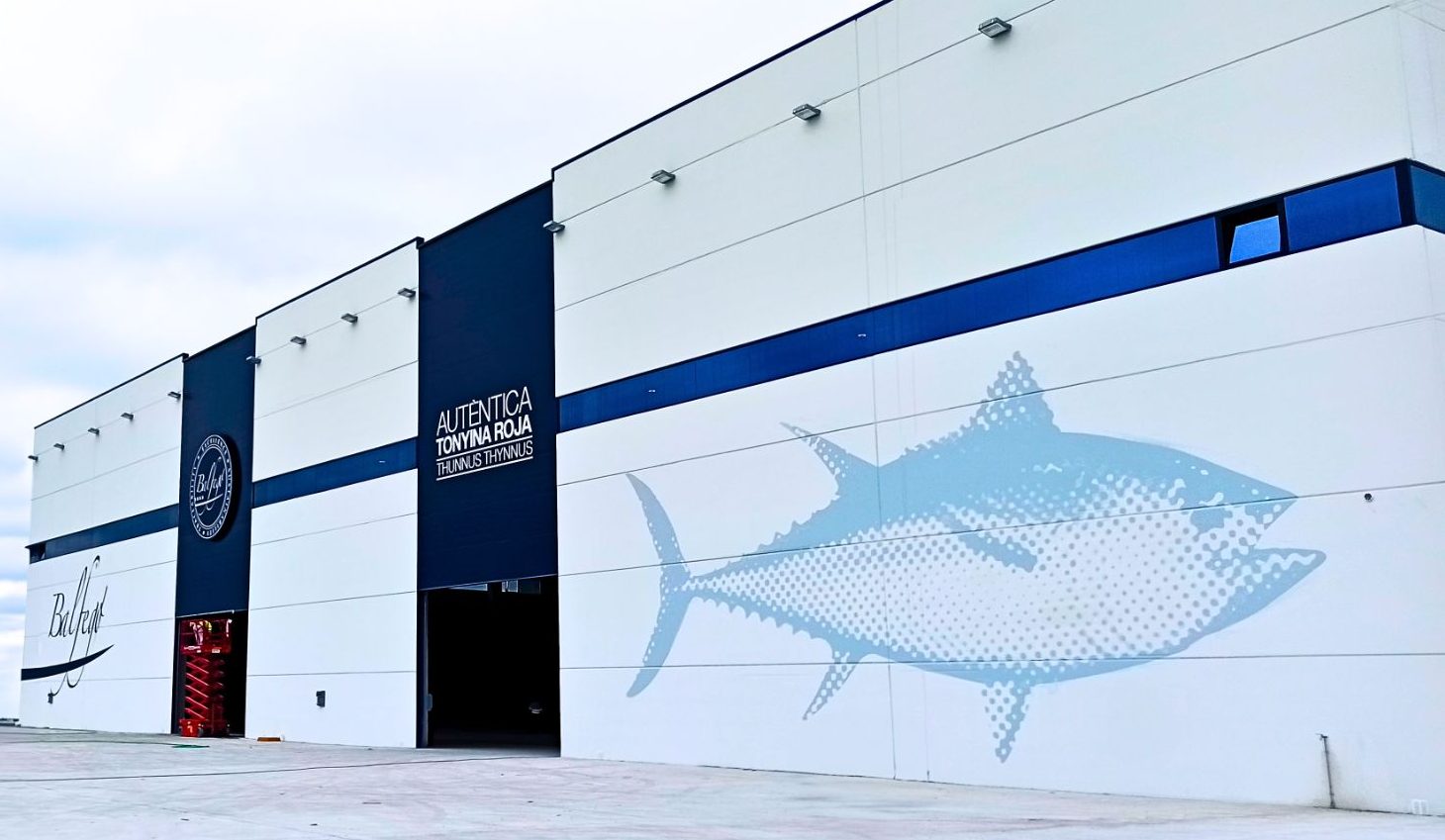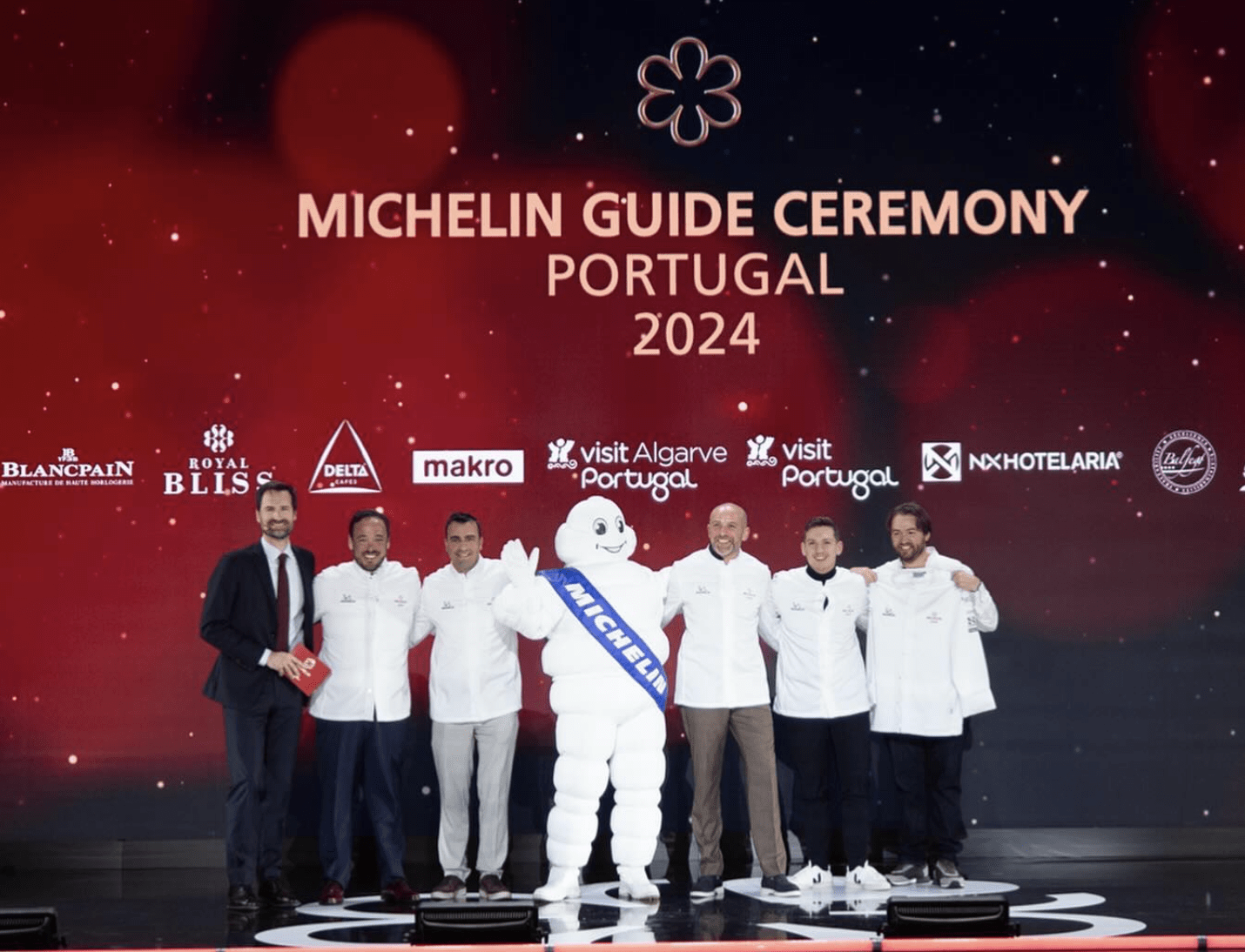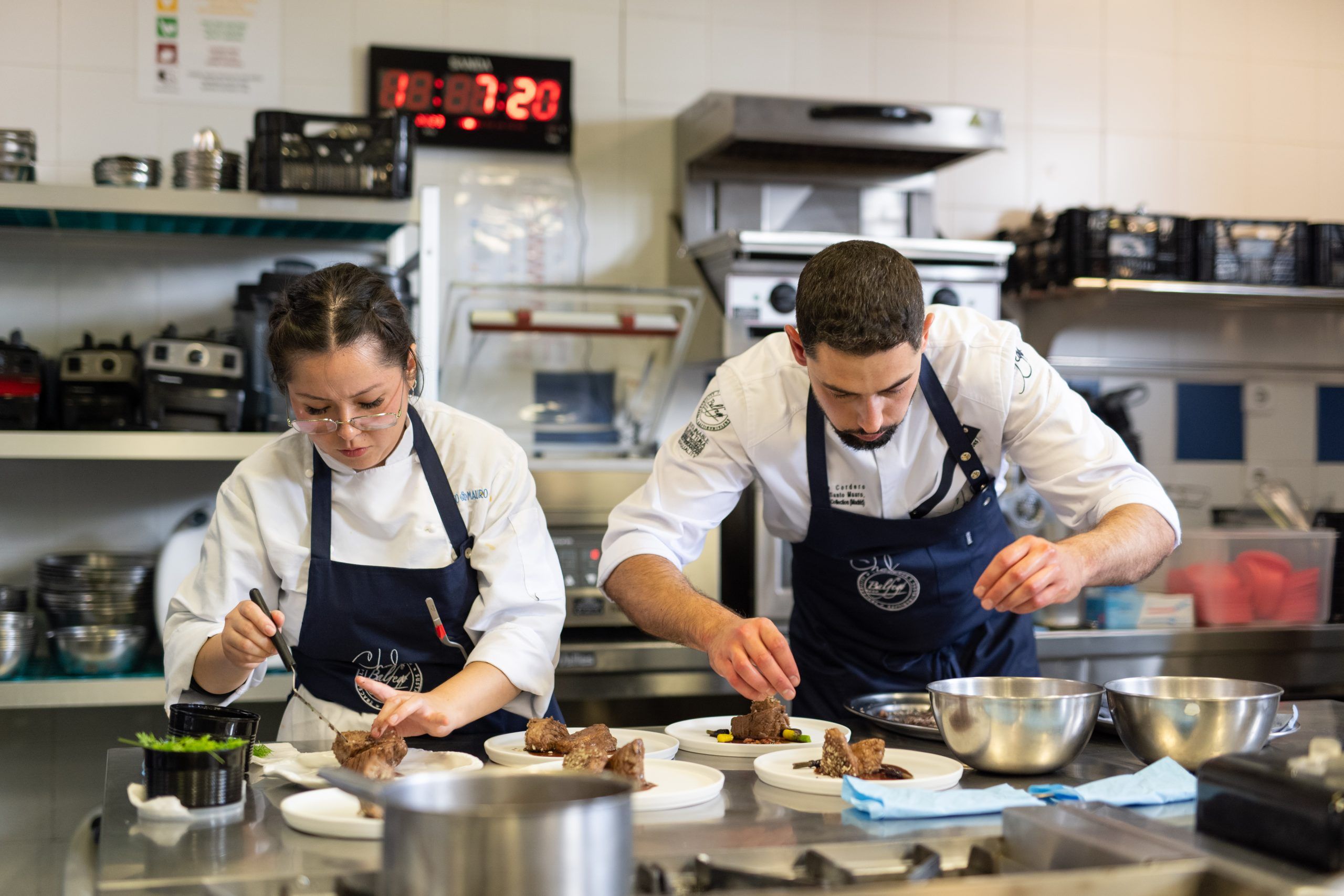
A swim with a tuna feast
Five generations of fishermen endorse the legacy of one of the most established tuna companies in our country. Balfegó, a company from L’Almetlla de Mar, opens the doors of its universe to the Repsol Guide, both in the water and on land. The first through snorkeling, diving and the art of fishing. The second, at ‘Tunateca‘, its restaurant in the heart of Barcelona, a sanctuary for bluefin tuna that marches to the beat of its own drum.
Long, long ago, a tuna spotted the warmest shores on the planet to lay its eggs. Some ended up in the Gulf of Mexico, others in Japan, some others in Australia, and finally, those who chose the Mediterranean. “In the market the most valued is the latter.” This comes from Joan Grau, head of marketing and communication at Balfegó. Five generations of fishermen tell the story of this family with roots in L’Ametlla de Mar, 40 minutes drive from Tarragona.

His purse seine technique gathers tuna in pools in the sea itself.
“In the 80s, cousins Pere Vicent and Salomé, together with Montse and Manel, joined forces to establish the company.” At the time they started selling all of their tuna to Japan, but in 2007 bluefin tuna fishing was regulated. “There was overexploitation of this animal, so some limits were set. While bluefin tuna is considered sexually mature at 25 kilos or more, the regulations established that it could be caught from 30 kilos. We catch it when it weighs 150 kilos, around 10 years old”. The objective: to fish within the assigned limits, but with the least number of tuna possible. “Let’s fish less so that in a few years there will be more stock.” Sustainability as a goal.
Tuna Tour visitors can dive with the animals as long as they have the proper certifications.
Two styles, two versions: made in Ametlla versus southern tuna fishing and gutting methods. There it was trapped or line caught; in the northern Mediterranean the purse seine technique was used, surrounding the tuna with pools created especially so that the animal feels that it is in its natural, wild environment. There ‘ronqueo’ quartering, here kaitai. Fishing in the time of traps, but without resorting to them. “We use the purse seine technique to bring the bluefin tuna from the Balearic Islands, where we fish them, to L´Ametlla. With this we managed to capture 100% wild tuna and keep them alive.”
 There’s also the chance to enjoy the spectacle from the surface by snorkeling.
There’s also the chance to enjoy the spectacle from the surface by snorkeling.
Tuna herding
The Balfegó team slowly bring their tuna from the Balearic Sea to the Mediterranean in Tarragona. Very slowly. “The interesting thing about the purse seine technique is that we bring the tuna here in a net – less than 2 kilometers per hour. While the purse seine boats arrive in 6 hours, the pools take 3 weeks to arrive”. Once in L’Ametlla the tuna fish go to the aquaculture facilities, where they will regain the weight they lost on their first long journey, from the Atlantic to the Mediterranean, when they swim at 70 kilometers per hour and where they lose around 30% of their body mass.
 The divers from the Balfegó team are in charge of slaughtering the tuna.
The divers from the Balfegó team are in charge of slaughtering the tuna.
The pools in L’Ametlla de Mar are the closest thing to a spa for Balfegó tunas. Their menu: mackerel, sardines, herrings, anchovies … “This has already been previously approved by our scientific department, to guarantee the quality of their food.” There they finish spawning, there they feed and there they occasionally coexist with those who dare to dive from the catamaran that Balfegó sets up as part of its Tuna Tour: “It is an experience where we explain what bluefin tuna is, where they live, what they feed on, what types of tuna there are and what fishing methods exists,” says David Puente, from Tuna Tour.
 The day ends with a tasting of bluefin tuna ‘sashimi’.
The day ends with a tasting of bluefin tuna ‘sashimi’.
There, two and a half miles from the beaches and coves of L’Ametlla, guests can swim among 300 tuna, the catch of a whole year. For those who prefer to experience it from the surface, there is snorkeling; for those who dare, and who have the qualification, there is diving – at about 20 meters deep – with two diving instructors. “For diving we ask that you have the Open Water certificate and 20 dives under your belt”, David continues.
 The Tuna Tour also details the process of collecting and treating the slaughtered fish.
The Tuna Tour also details the process of collecting and treating the slaughtered fish.
The culture of bluefin tuna is promoted from all angles: from the water, from the catamaran where audiovisuals are projected for an audience of all ages – including children – culminating with a small tasting of sashimi along with, if you like, exquisite cava. A journey where the credentials of Balfegó fishing are explained: traceability, sustainability, transparency, documentation and certification. Then the fish gutting takes place, which is performed using ikejime . “It’s a Japanese technique that does not impose stress or suffering on the tuna. Several divers are in charge of descending between 10 and 20 meters, who then shoot the fish in the head. Then we put the tuna on the boat, and we put a rod through its spinal cord which certifies rigor mortis”, says Joan.
 Measurements, pool of origin, traceability … This data is recorded in the QR code of each tuna.
Measurements, pool of origin, traceability … This data is recorded in the QR code of each tuna.
R&D to elevate the product
At Balfegó they gut their tuna straight away to prevent anisakis from passing into the muscle. A practice certified by AENOR, which endorses the company’s good practices in preventing these parasites. They also cut a small piece out before the tail. “Their traceability begins here, their ID” A blue label will act as the the ID for each of the tuna that will be presented with a QR code at the next Balfegó family stronghold: ‘Tunateca’. “All the tuna that you eat with us has a QR that specifies when it was caught, what pool it came from, what it measured, how much it weighed, the percentage of fat and selenium, and the health certificates that we currently have.”
 Watching the tuna selection process is quite a spectacle.
Watching the tuna selection process is quite a spectacle.
It is the final part of this experience for diners who would like to take another dive, but are now on the surface and have no oxygen tank. At number 439 Avenida Diagonal in Barcelona, Ekaitz Apraiz works his magic and delves into R&D in this gastronomic space and experimentation center dedicated to Mediterranean bluefin tuna. Ekaitz sits at the table and watches the diners savoring his dishes. He watches calmly, talking about tuna and life, books and restaurants, circular economy. “No part of the tuna goes to waste. Our kitchen team is constantly innovating. We are now testing a tuna garum, but the tests we are doing go beyond strict gastronomy and we will soon be able to tell you more ”.
 “Tunateca” is the restaurant where Balfegó displays the full potential of this product.
“Tunateca” is the restaurant where Balfegó displays the full potential of this product.
20 people work in the Balfegó lab, divided between those dedicated to sustainability and innovation and ten people in the kitchen. They all create, they all drive a gear that brings the land closer to the sea, and the sea onto land. The ultimate expression of this is its Red Menu: Taking you through all the cuts of bluefin tuna through the Mediterranean and Japanese vision, all in 13 steps. New appetizers are on the menu, accompanied by a Classic Penedés cava – a 2019 brut nature, “from a family we love very much”, says David Vázquez, sommelier at ‘Tunateca’.

The menu is made up of dishes like ‘chutoro nigiris’ with caviar, with ‘shichimi togarash’i and ‘otoro yuzukosho’.
Tuna belly and cockle ceviche with yellow pepper with a Pisco Sour foam. Tuna belly tartare, crushed potato chips, Espinaler sauce spheres and a red vermouth gelée. All in one bite, enjoying the finger food philosophy in a space filled with undulating lights, imitating how the sun’s rays shine on the Mediterranean. The spicy chutoro Nigiri 11 – from sichimi togarashi – puts an end to the appetizers with a hot soup made from beans that “pays tribute to Japanese hot springs,” says Ekaitz. Flambéed, with green beans on top and an extract of white beans.
 Ekaitz Apraiz is in charge of leading a kitchen with a ‘Basque-Catalan-Japanese’ philosophy.
Ekaitz Apraiz is in charge of leading a kitchen with a ‘Basque-Catalan-Japanese’ philosophy.
‘Basque-Catalan-Japanese’ philosophy
Ekaitz Apraiz likes broths. “We like to make reductions from which we can bring out the umami flavor,” says the chef. After finishing the bowl, Balfegó’s Japanese vision comes to the fore. It opens with the traditional sashimi trilogy accompanied by a natural wasabi from Catalonia, which in ‘Tunateca’ is grated over shark skin. “It’s a milestone, Catalonia has become the first place in continental Europe where wasabi is produced,” says Ekaitz. Three textures, three colors, three flavors”. Otoro (belly), which is the most marbled, with the most fat; chutoro, the part closest to the skin, and the akami. “It is advisable to go from leaner to fattier.”
 The ‘temaki’ tuna and eel tartare ‘kabayaki’ is a perfectly balanced dish.
The ‘temaki’ tuna and eel tartare ‘kabayaki’ is a perfectly balanced dish.
Someone asks Ekaitz about soy sauce for the trilogy. “It’s actually shoyu dashi with alka kombu, katsuobushi, mirin (a type of sake) and mineral water, that’s why it’s much more pleasant,” says Ekaitz, making his case with his Basque-Catalan-Japanese philosophy. He’s an eternal traveler, after all. “Why is bluefin tuna called ‘rojo’ (red) in Spanish? “Because it has always been fished in season. Tuna live in Norway, Ireland, Scotland, Canada … and come to the Mediterranean to breed. When they pass through the Strait they have used up all their calorie reserves, so they get thinner. This is when they are redder, because the rest of the year, when they have recovered their fat, their flesh is more pink”.

The shoal of glass tuna on the ceiling of ‘Tunateca’ transports you to the sea.
Balfegó markets its tuna with a percentage of around 9% fat. Those varying degrees of color dance on the table to the rhythm set by this chef from Buzturia – between Bermeo and Gernika. The Japanese version continues with more nigiris: of chutoro with Iranian Osetra, with sichimi togarashi and yuzukoshō otoro. In Japanese culture, what is done by hand is also eaten by hand. “But it is still just a recommendation,” says Ekaitz, while the temaki of tuna tartare and kabayaki eel and the gunkan of otoro tamago come out.
 The bluefin tuna loin is accompanied by burrata, yellow pepper, fine herb sorbet and tomato soup.
The bluefin tuna loin is accompanied by burrata, yellow pepper, fine herb sorbet and tomato soup.
Mastery beyond tuna
His style is the result of everyday life in ‘Tunateca’. A self-learning process that has resulted in 100% utilisation of the tuna. The ear, the harmonica… “soon there’ll be more”, he says, laughing. In his speech, between the lines, there are always nods to the pig linking both Iberians, that of the land and that of the sea. Also ducks. An ideal context for when the starters take center stage at the table: Tuna palate carpaccio with aged beef tartare, quail yolk and tartufatto. Bluefin loin tartare, burrata, yellow pepper sauce, fine herb sorbet and tomato soup. And the akami with romesco and kimchi cream, confit negi and smoked Garrotxa cheese spheres.
 At ‘Tunateca’ they serve tuna in all its forms, such as ‘sashimi’, ‘carpaccio’ or on the grill.
At ‘Tunateca’ they serve tuna in all its forms, such as ‘sashimi’, ‘carpaccio’ or on the grill.
“Every two weeks, one of the three people in the kitchen goes on a tasting ban, that is, we don’t eat tuna all week, because our palate gets saturated and confused, even bored”. That ban then frees the mind and body to create things like their creamy tuna cheek rice with mushrooms and tender garlic. Or its grilled tuna neck with scallop sashimi and its bluefin sirloin with grilled foie gras and onion textures.
Ekaitz is inspired by Japan, its people. “Their passion for what they do and their meticulousness, I adore them.” Oriental perfection versus the Mediterranean culture of enjoyment. Mouthfuls and cuts that unite both lands, in a gastronomic melting pot that includes Xarel.lo grapes from Penedés, from Bodegas Luis Soler winery, a red wine from Clos Figueras DO Priorat, a tepache, a fermented pineapple juice from Mexico and a tokai, a Hungarian wine, “a classic sweet wine”, David’s craving. Isn’t there sake? Yes there is, made from rice from the Ebro Delta. “We have one that they make with the melted water from the thaw, with a lot of fruity notes, and we drink it with a glass of wine so that its olfactory properties bring out those nuances”.
 The place, in the heart of Diagonal de Barcelona, is a cult temple for bluefin tuna lovers.
The place, in the heart of Diagonal de Barcelona, is a cult temple for bluefin tuna lovers.
Like Ekaitz, sake accompanies the bluefin tuna parade in ‘Tunateca’, in a kind of ceremony created involuntarily by the chef himself. A liturgy that brings the East closer to the West in the most natural and authentic way possible. “Everybody feeds off each other.” The sushi men Gao and Carlos do, at the bar where they age drinks with the Japanese method. As does the diner with the glass tuna on the ceiling of this gastro-educational space. Like them, the Balfegó team, with the Mediterranean, returning gratitude to the sea for all that it has been giving them for decades.
– Plaça Polígon Industrial, 1. L’Ametlla de Mar, Tarragona. Tel. +34 977 04 77 00.
– Catamará Tuna Tour, Puerto L’Ametlla de Mar, n/n. L’Ametlla de Mar, Tarragona. Tel: +34 977 04 77 07.
– Avenida Diagonal, 439. Barcelona. Tel. +34 937 97 64 60.
 The dessert is a pineapple tartare delight with pistachio praline, coconut ice cream and biscuit accompanied by tepache.
The dessert is a pineapple tartare delight with pistachio praline, coconut ice cream and biscuit accompanied by tepache.







